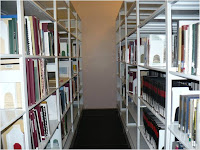Collection development (also known as collection management) is the term used to describe the evaluative process used by librarians to choose the items to be included in a particular library or sub-section thereof. There are many factors and variables that a librarian must take into account in this process (e.g. budget/pricing, accessibility, audience, popularity/reliability, trends, etc.). And, every couple of years or so, librarians revisit collection development documents. The latest version of the Library System's document is found at http://www.beaufortcountylibrary.org/content/beaufort-county-librarys-collection-development-policy. This document applies to the regular circulating branches of the Library system where the stock is often under continuous change.
The situation in a special collections and archives unit like the Beaufort District Collection is a little different. Every item in our collection has to be used in our Research Room under monitored conditions. What gets chosen for our collection has to stay in our collection forever. Therefore, we do not concentrate on the newest and brightest materials or the most popular or the highest demand titles within the general publishing sphere. Our goal is to grow, maintain, and share a research collection of permanent and enduring value about a very narrow scope, that is, about the history, culture, and natural environment of the people, places, topics, events, and themes of this particular part of lowcountry South Carolina.
For a special collections librarian and archivist, the selection process can be quite time-consuming. It can sometimes be rather difficult particularly when a proposed donation just doesn't "fit" our policy. But on the whole, it is a fun professional exercise.
As a rule of thumb, a material proposed for inclusion in the Beaufort District Collection must be about the history, culture and/or natural environment of this unique area. We don't get hung up on the form of the information. Our focus is the content first, then the package that contains the content. We take care of a variety of formats: books, magazines, DVDs, VHS tapes, cassettes, phonograph records, photographs, digital images, maps, art prints, and even a couple of samples of phosphate rock. An appropriate material for inclusion in the Library system's local history special collection and archives could be just about anything that would help illuminate the history, culture, and environment of this particular area - although we try to stay away from acquiring realia as that is more the province of our colleagues in the museum field.
Because we are a special collection and an archives, our materials do not always come in discrete pre-packaged form (book, DVD, or magazine). The crucial element in those cases is how much of the material actually informs on the history, culture, and natural environment of the former Beaufort District in relation to the other topics included in the material being considered. Generally speaking, if the applicable part of the pre-packaged form is 20 pages or less, we simply photocopy the appropriate pages (with proper citation, of course) and add the photocopies to the proper historical vertical file. Doing so allows us to shepherd our very limited budget for purchasing items.
If we are considering an audio-visual material, we figure in whether or not we have the appropriate hardware and/or software to view and migrate the material (We have that long-term 100 year watch, you know) and the amount of relevant information about Beaufort District within the package.
When considering whether or not to accession personal papers or other archival material, we weigh out the amount of original and unique information likely contained therein about the people, places, events, and themes of Beaufort District history, culture and the natural environment, the cost and time frame of preparing the materials for use, preserving the materials for use, arranging and describing the materials for use, and the amount of space the collection will need for proper storage. With a staff of only two, and a few dedicated docents who do a lot of the routine preservation tasks, the labor and time factor necessary to get the materials under intellectual and physical control for use by customers is very important consideration in whether or not we ultimately add a particular collection to the archives.
In other words, in special collections and archives, the process of acquiring materials involves analysis, assessment, and evaluation, and can ultimately be more art than science.


No comments:
Post a Comment